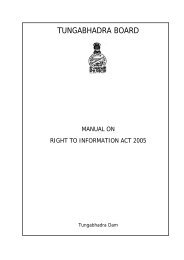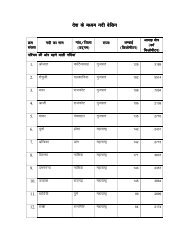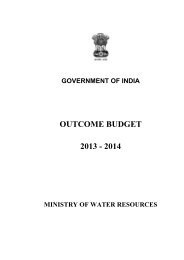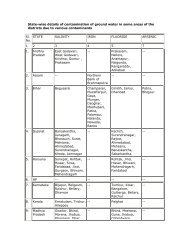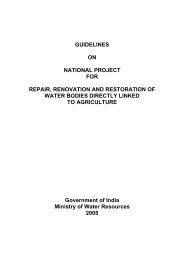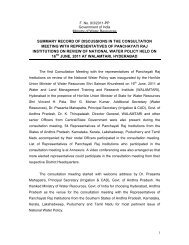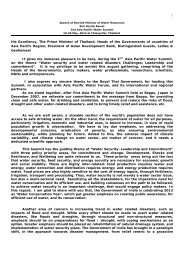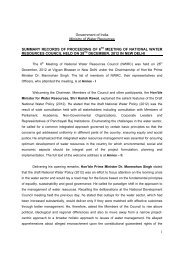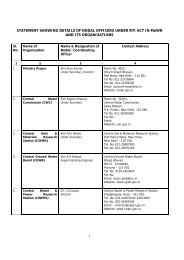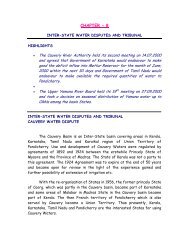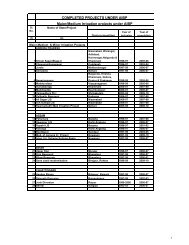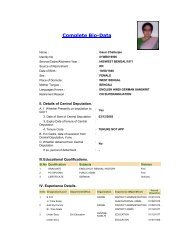Guidelines - Repair, Renovation and Restoration - Water Bodies with
Guidelines - Repair, Renovation and Restoration - Water Bodies with
Guidelines - Repair, Renovation and Restoration - Water Bodies with
You also want an ePaper? Increase the reach of your titles
YUMPU automatically turns print PDFs into web optimized ePapers that Google loves.
GUIDELINESFORREPAIR, RENOVATION AND RESTORATIONOFWATER BODIES WITH DOMESTIC SUPPORTGovernment of IndiaMinistry of <strong>Water</strong> Resources2009
I N D E XCONTENTSPAGE NO.1. Introduction 12. Basic Features of the Scheme 1-33. Planning of the projects under the Scheme3.1 Identification <strong>and</strong> Selection of <strong>Water</strong> <strong>Bodies</strong> 33.2 Preparation of DPRs 3-54. Implementation of the Scheme4.1 Arrangements at Village/Block Level 64.2 Arrangements at District Level 64.3 Arrangements at State Level 6-74.4 Arrangements at Central Level 75. Procedure for submission of proposals 7-86. Release of funds 8-97. Monitoring <strong>and</strong> Evaluation 9Annexes1. Flow Chart indicating implementation arrangements 102. Activity Mapping in relation to the Role of Panchayatsin the Implementation of the Scheme 113. Check List for processing the release of funds by theMinistry of <strong>Water</strong> Resources 12
1. Introduction1.1 In India, tanks/ponds & lakes have traditionally played an important rolein irrigation, drinking water supply, hydropower, ecology, tourism/culture <strong>and</strong>domestic use. Relative importance of some of these <strong>Water</strong> <strong>Bodies</strong> has waneddue to a number of reasons such as shifting away from community based tanksystem to individual beneficiary oriented ground water dependent system,encroachments, silting, population pressure, multiplicity of agenciesresponsible for their upkeep, etc.1.2 A pilot scheme for “<strong>Repair</strong>, <strong>Renovation</strong> <strong>and</strong> <strong>Restoration</strong> (RRR) of <strong>Water</strong><strong>Bodies</strong> directly linked to Agriculture” was launched in January 2005 forimplementation during the remaining period of X Plan <strong>with</strong> an outlay ofRs.300 crores. The Scheme was sanctioned in respect of 1098 water bodies in26 districts of 15 States <strong>with</strong> a target to create 0.78 lakh hectares of additionalirrigation potential.1.3 Keeping in view the success of the pilot scheme for RRR of water bodies<strong>and</strong> need for a comprehensive programme to upscale the gains from waterbodies, the Ministry has launched the scheme of <strong>Repair</strong>, <strong>Renovation</strong> <strong>and</strong><strong>Restoration</strong> (RRR) of <strong>Water</strong> <strong>Bodies</strong> as a State Sector scheme <strong>with</strong> domesticbudgetary support. The scheme will be applicable in whole of the country.2. Basic Features of the Scheme :2.1 Under the scheme, about one lakh water bodies having a CulturableComm<strong>and</strong> Area (CCA) of 9 lakh ha. at a cost of Rs. 4,000 crore includingcentral share of Rs.1250 crore would be covered. The main objectives of thescheme are:(i) Comprehensive improvement of selected tank systems includingrestoration.(ii) Improvement of catchment areas of tank.
(iii) Community participation <strong>and</strong> self-supporting system forsustainable management for water bodies covered by theprogramme.(iv) Ground <strong>Water</strong> Recharge.(v) Capacity Building of communities, user groups st<strong>and</strong>ing committeefor Panchayats <strong>and</strong> State Government/Central GovernmentAgencies concerned <strong>with</strong> the planning, implementation <strong>and</strong>monitoring of the project.(vi) Increase in storage capacity of water bodies.(vii) Improvement in agriculture/horticulture productivity <strong>and</strong> increasein recharge of ground water in downstream areas of water bodies.(viii) Environmental benefits through improved water use efficiency;irrigation benefits through restoration of water bodies,supplementation of the groundwater use <strong>and</strong> promotion ofconjunctive use of surface <strong>and</strong> ground water.(ix) Development of tourism, cultural activities, etc.(x) Increased availability of drinking water.2.2 The funding pattern for the scheme is given below:-(i) For Special Category States (North-Eastern States including Sikkim,Himachal Pradesh, Jammu & Kashmir, Uttarakh<strong>and</strong> <strong>and</strong> undividedKoraput, Bolangir <strong>and</strong> Kalah<strong>and</strong>i (KBK) districts of Orissa) as well asprojects benefitting drought prone/tribal/naxal-affected areas, 90%of the project cost will be provided as Central Assistance (grant) bythe Government of India <strong>and</strong> 10% of the cost by State Governments.(ii) For non-special category States 25% of the cost will be provided asCentral Assistance (grant) by Government of India <strong>and</strong> 75% by StateGovernments.(iii) 10% of the project cost will be earmarked by the State Governmentsfor capacity building, awareness <strong>and</strong> institutional strengthening.
(iv)Out of the Central Plan, outlay of Rs. 1250 crore available for thescheme during the XI Plan, 5% of the central share shall be made forstrengthening of implementation mechanism, concurrent evaluation<strong>and</strong> impact assessment to be carried out by the independent agenciesidentified by the Ministry of <strong>Water</strong> Resources <strong>and</strong> will be released onthe recommendation of the Ministry.3. Planning of the projects under the scheme:The States may take up planning <strong>and</strong> implementation of projects underthe scheme generally in the manner outlined below:3.1 Identification <strong>and</strong> selection of water bodies:(i) A project may be prepared <strong>with</strong> an individual water body or for a groupof water bodies <strong>with</strong> sub-basin approach. All public <strong>and</strong> communityowned water bodies may be covered under the project. All water bodiesincluded in the project will be given a unique code number. States willaccordingly undertake census of these water bodies <strong>and</strong> get complete listof water bodies along <strong>with</strong> unique code in the first stage.(ii) The States may take up the repair, renovation <strong>and</strong> restoration of waterbodies having original irrigation culturable comm<strong>and</strong> area up to 2000hectare or less, for drinking water, irrigation, pisciculture, tourism,ground water recharge or any other purposes.(iii) Private owned water bodies are not to be considered for funding underthis scheme.3.2 Preparation of Detailed Project Reports (DPR):The DPR of a project has to include information on the followingaspects:3.2.1 Details of present status of the water bodies (in use or partially used ornot in use) <strong>with</strong> reasons for deterioration in condition <strong>and</strong> also itscategorization in terms of location in (i) special category states/ Districts
(North-Eastern States including Sikkim, Himachal Pradesh, Jammu &Kashmir, Uttarakh<strong>and</strong> <strong>and</strong> undivided Koraput, Bolangir <strong>and</strong> Kalah<strong>and</strong>i(KBK) districts of Orissa) (ii) drought prone, tribal <strong>and</strong> naxal-affectedareas in non- special category states (iii) other areas not covered undercategory (i) <strong>and</strong> (ii).3.2.2 Rainfall during the last ten years, ground water level, l<strong>and</strong> use pattern,soil characteristics, climate conditions, availability of water in thecatchment area for channelization into water body, water quality situationin the water body <strong>and</strong> adjoining areas.3.2.3 Details of original CCA, present CCA <strong>and</strong> CCA planned in the DPR,original storage capacity/present storage capacity <strong>and</strong> storage capacityplanned in the DPR, water quality situation in the water body <strong>and</strong> ofground water in adjoining areas <strong>with</strong> likely impact of the project on waterquality of the water body <strong>and</strong> of the ground water.3.2.4 Scope of work –Scope of work in the DPR may include the following:-De-silting in terms of quantum of silt to be removed, repair ofconveyance system, strengthening of bund(s), repair of weirs <strong>and</strong> sluices,catchment treatment, comm<strong>and</strong> area development, soil erosionprevention works, quality control measures.Maps of catchment <strong>and</strong> comm<strong>and</strong> areas are to be enclosed in the DPR.3.2.5 The scheme envisages capacity building of implementing agenciessuch as Ministry of <strong>Water</strong> Resources (MoWR) <strong>and</strong> its attached <strong>and</strong>subordinate offices, State Governments, District Implementingagencies, <strong>Water</strong> Users’ Associations (WUAs) <strong>and</strong> Panchayats.Accordingly, a capacity building programme aimed at sensitization ofstakeholders, identification <strong>and</strong> selection of water bodies, preparationof Detailed Project Reports (DPRs), monitoring <strong>and</strong> evaluation is tobe prepared <strong>and</strong> included in the DPRs.
3.2.6 Plan for convergence <strong>with</strong> the efforts made under other programmessuch as National Rural Employment Guarantee Programme (NREGP),watershed development programme <strong>and</strong> scheme of rural drinkingwater supply. The joint guidelines for convergence between NREGP<strong>and</strong> programmes of Ministry of <strong>Water</strong> Resources have already beenissued in this regard. Detailed guidelines may be seen on Ministry’swebsite at http://mowr.gov.in or Ministry of Rural Developmentwebsite at http://rural.nic.in.3.2.7 Plan for convergence <strong>with</strong> schemes of agriculture departmentaimed at generating additional irrigation potential <strong>and</strong> increasingwater use efficiency; <strong>with</strong> schemes of ground water department <strong>and</strong>Central Ground <strong>Water</strong> Board (CGWB) aimed at ground waterrecharge <strong>and</strong> <strong>with</strong> schemes of Drinking <strong>Water</strong> Supply Departmentof the state aimed at sustainability of drinking water sources.3.2.8 Targetted benefits under the project will include creation ofadditional irrigation potential, Increase inagriculture/horticulture/pisciculture production <strong>and</strong> productivity,increase in recharge of ground water, improvement in water useefficiency, increase in availability of drinking water, impact onwater quality, promotion of tourism <strong>and</strong> culture.3.2.9 Benefit Cost ratio (BC ratio) has to be minimum 1:1 in SpecialCategory States, undivided KBK districts of Orissa, in droughtprone, tribal <strong>and</strong> naxal-affected areas <strong>and</strong> 1.5:1 in other areas.3.2.10 Implementation schedule & corresponding requirement of funds;details of arrangement for monitoring & evaluation <strong>and</strong> ofarrangement for use <strong>and</strong> maintenance of the restored water bodies.
4. Implementation of the Scheme4.1 Arrangements at Village/Block Level(i) At the water body level, the scheme is to be implemented either by thelocal Panchayat or a WUA or a government agency identified by theDistrict Level Implementing Agency.(ii) The completion plan of the project will be placed before the GramSabha <strong>and</strong> its cooperation will be solicited for timely completion of theproject. The Activity Mapping in relation to the role of Panchayat in theimplementation of the scheme is at Annexure II.4.2 Arrangements at District Level(i) At the district level, the concerned State Government will identify, <strong>and</strong> ifnecessary, promote an Implementation Agency for the scheme which willcoordinate the programme. There will be a District Level Implementation<strong>and</strong> Monitoring Committee (DLI&MC) under the chairmanship ofDistrict Collector to decide issues relating to implementation,management, supervision <strong>and</strong> effectiveness of the project. TheCommittee shall include district level nodal officer from CGWB.(ii) District Magistrates/Collectors will constitute DLI&MCs <strong>and</strong> get thestrategy/perspective plans for implementation of scheme finalized.4.3 Arrangements at State Level(i) A State Level Nodal Agency (SLNA) will be identified by the StateGovernment which will be responsible to plan various activitiesenvisaged under the scheme, monitor their implementation, provideguidance to DLIA & DLI&MC <strong>and</strong> ensure coordination amongst allconcerned departments/agencies at the state level.(ii) The State Government may engage the services of competent agencies tosupport activities for awareness creation, capacity building, preparationof DPRs <strong>and</strong> monitoring of the scheme.
(iii) A Technical Advisory Committee (TAC) will be constituted by the Stateto techno-economically appraise <strong>and</strong> approve the DPR. TAC shall alsoinclude representatives from Central <strong>Water</strong> Commission (CWC) <strong>and</strong>Central Ground <strong>Water</strong> Board (CGWB).4.4 Arrangements at Central LevelThe Ministry of <strong>Water</strong> Resources will coordinate the programme at thecentral level. A flow chart indicating the implementation arrangement is atAnnexure-I. The role of the Ministry will be to:i. facilitate awareness creation about the scheme amongstakeholders,ii. monitor the progress under the scheme through periodic reportsfrom the states <strong>and</strong> field visits.iii.iv.provide general guidance to states on all matters relating to theimplementation of the scheme.consider approval of projects received from the states forassistance under the scheme.v. get the post implementation evaluation <strong>and</strong> impact assessmentof the projects done.vi.vii.provide technical assistance to states through field offices ofCGWB.provide check lists for preparation of DPR <strong>and</strong> submission ofproposals for release of central assistance.5. Procedure for Submission of proposals(i) In case of Panchayats, the projects are to be prepared <strong>and</strong>forwarded to the District Planning Committee (DPC) forinclusion in the District Plan. The Detailed Project Reports(DPRs), will then be forwarded to District Level
Implementation Agency (DLIA) for onward transmission tothe State Level Nodal Agency (SLNA).(ii) Projects taken up by WUAs <strong>and</strong> Government Departments areto be prepared in consultation <strong>with</strong> the St<strong>and</strong>ing Committee ofGram Panchayats on <strong>Water</strong> Resources <strong>and</strong> the DPRs thereofare to be forwarded to DLIA for onward transmission toSLNA. A copy of the Projects is to be sent also to the DPC.(iii) After approval of the DPR by state TAC, the States will submitDPRs to the Ministry of <strong>Water</strong> Resources, which in turn willtake further necessary action for release of funds under thescheme.6. Release of funds:(i) Necessary budget provision for the total amount of the project forboth Central <strong>and</strong> State shares are to be kept in the State Plan Budgetfor the relevant year.(ii) The first installment of 70% central share will be released onsubmission of approved DPRs provided adequate provision for thesame has been made in the State budget. The balance 30% centralshare will be released on utilization of 75% of the first installment ofCentral Assistance along <strong>with</strong> corresponding State share <strong>and</strong> receiptof utilization certificate in the prescribed format duly countersignedby the authorized officer of the concerned department of StateGovernment.(iii) The check list for processing the release of funds by the Ministry of<strong>Water</strong> Resources, Government of India is enclosed as Annexure III.7. Monitoring <strong>and</strong> Evaluation:(i) Regular monitoring of the project is to be carried out at each stage.Monitoring has to include the maintaining of both physical <strong>and</strong> financial
(ii)progress <strong>and</strong> the outcome. Monitoring will be done <strong>with</strong> the associationof the st<strong>and</strong>ing committee of the Panchayat at the appropriate level.Baseline survey is to be conducted before the commencement of theproject execution. Evaluation <strong>and</strong> impact assessment of the scheme willbe done by independent agencies to be identified by the Ministry of<strong>Water</strong> Resources. Necessary reports <strong>and</strong> field visits are to be made onregular basis for the purpose.
Annexure – IIMPLEMENTATION ARRANGEMENTSIdentification of <strong>Water</strong> <strong>Bodies</strong> <strong>with</strong> Unique CodePreparation of DPRs by Field levelImplementation AgenciesPanchayatsGovernmentAgencies<strong>Water</strong> UsersAssociationcopycopyDistrict PlanningCommittee(for inclusion in districtplan)District LevelImplementation& MonitoringCommitteeDistrict Level Implementation AgencyState TAC(Approval ofDPRs)State Level Nodal AgencyMinistry of <strong>Water</strong> Resources(Processing of DPRs & recommend releaseof funds to MOF)Ministry of Finance(Release of funds to States)
Name ofScheme<strong>Repair</strong>s,<strong>Renovation</strong>&<strong>Restoration</strong>of <strong>Water</strong><strong>Bodies</strong>Annexure- IIActivity Mapping in relation to the Role of Panchayats in theImplementation of the SchemeNational State District Panchayat<strong>and</strong> DistrictPlanning Committee(i) Ministry of<strong>Water</strong>Resources willtake necessaryaction on theDPRssubmitted bythe State dulyapproved bythe TACs.(ii) Ministry ofPanchayatiRaj willprovidenecessaryfacilitation<strong>and</strong> supportfor effectiveparticipationof Panchayatsinimplementation of theScheme.(i) The State willprepare theproject taking intoconsideration thenumber of publicwater bodiesrequired to beincluded in theproject preferably<strong>with</strong> the subbasinapproach.(ii) Status ofground waterlevels <strong>and</strong>hydrologicalfeatures in theparticular regionwould be dulyconsidered whileselecting thewater bodies.(iii) State willhave an interdisciplinaryTechnicalAdvisoryCommittee toselect <strong>and</strong>approve thedetailed ProjectReports.(iv) State willsubmit the DPRsduly approved bythe TechnicalAdvisoryCommittee to theMinistry of <strong>Water</strong>Resources.(i)The District LevelImplementationAgency will beresponsible foractivities relating tofinalization ofimplementationstrategy,management plan,monitoring,supervision <strong>and</strong>other measuresnecessary forefficientimplementation ofthe project.(ii) DPCs will beadvised to includeprojects for repair,renovation <strong>and</strong>restoration of waterbodies in the Districtplan.(iii) Necessarycooperation of thest<strong>and</strong>ing committeeof the Panchayats on<strong>Water</strong> Resources willbe sought inmonitoring of theprojects.(iv)StateGovernments mayassign appropriateresponsibility toPanchayats atdifferent levels. StateGovernments mayalso decide forrelease of funds toPanchayats at theappropriate level forimplementationthe project.ofBlockPanchayat(i) Necessarycooperation ofthe Panchyatson <strong>Water</strong>Resources willbe sought inmonitoring ofthe projects.(ii)Maintenanceworks to beundertaken bytheImplementingAgency itself<strong>and</strong> revivedwater bodiesmay be h<strong>and</strong>edover toappropriatemanagementbody, as maybe decided bythe concernedStatGovernment.Village Panchayat <strong>and</strong>Gram Sabha(i)Project Area, beneficiaries<strong>and</strong> capacity buildingcomponents will be decidedby DLIA in consultation <strong>with</strong>concerned stakeholderincluding Panchayats atappropriate level.(ii) The Completion plan willbe placed before the GramSabha <strong>and</strong> the PRIsconcerned.(iii)The St<strong>and</strong>ing/Sub-Committee of GramPanchayat will be associatedfor the selection of works/siteof the project <strong>and</strong>implementation of theproject.(iv. The social audit of theproject will be carried out bythe Gram Sabha(v)Maintenance works to beundertaken by theImplementing Agency itself<strong>and</strong> revived water bodiesmay be h<strong>and</strong>ed over toappropriate managementbody, as may be decided bythe concerned StateGovernment.
The Check List for processing the release of funds by theMinistry of <strong>Water</strong> ResourcesAnnexure-IIISl. No. Item Yes/No1. Whether census of water bodies completed <strong>and</strong> assignedunique code number?2. Whether only water bodies having CCA upto 2000hectare included?3. Are private water bodies included in the DPR?4. Whether concerned stakeholders including panchayatshave been associated for selection of water bodies <strong>and</strong>capacity building?5. Whether water bodies are included in the district plan?6. Whether rain fall data for last 10 years, ground waterlevel, l<strong>and</strong> use pattern, water quality situation in thewater bodies <strong>and</strong> adjoining areas have been included?7. Whether details of original CCA/present CCA/CCAexpected after rejuvenation have been included?8. Whether details of original storage capacity/presentstorage capacity <strong>and</strong> storage capacity expected afterrejuvenation have been included?9. Whether maps of catchment <strong>and</strong> comm<strong>and</strong> are enclosed?10. Whether benefit cost ratio has been incorporated?11. Whether implementation schedule <strong>and</strong> correspondingrequirement of funds, details of arrangements formonitoring <strong>and</strong> evaluation has been included?12. Whether convergence <strong>with</strong> NREGS or other schemeshave been taken into account?13. Whether DLI&MC has been constituted?14. Whether District Level Implementing Agency has beenidentified?15. Whether State Level Nodal Agency has been identifiedby the State government?16. Whether Technical Advisory Committee has beenconstituted?17. Whether the DPR has been approved by TAC?



